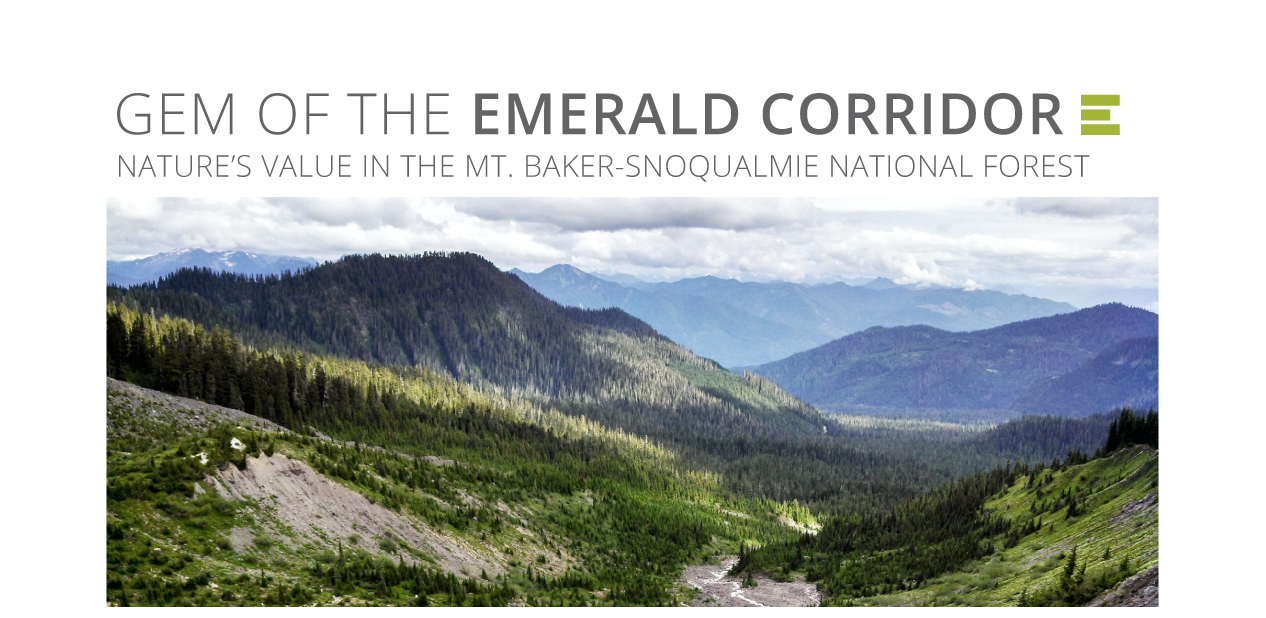“The Gem of the Emerald Corridor report provides economic data that validates what we are reminded of every time we venture to the forest and return the better for it.”
A TRILLION-DOLLAR FOREST IN THE REGION OF BOOM
Download our report.
The Emerald Corridor comprises one of the fastest-growing regions in the nation. With a regional economy of $347 billion and a population of 4.5 million people and counting, the Emerald Corridor is an important economy on the rise. In our recent report for the Wilderness Society - Gem of the Emerald Corridor: Nature’s Value in the Mt. Baker-Snoqualmie National Forest - we took a look at how nature is driving this growth, and the results are pretty eye-opening. If we view the Mount Baker-Snoqualmie National Forest (MBSNF) as a natural asset that will provide valuable services, products, and jobs to our regional economy for at least 100 years (as we should...), its total asset value is estimated to be $1 trillion. Trillion. With a T.
If you’ve been following Earth Economics for any amount of time, you already know that nature and the economy are not separate. Nature drives our economy, and the booming Emerald Corridor owes much of its incredible success to the enormous wealth of natural resources that surround it. The forest provides nearly $30 billion dollars in ecosystem services to surrounding communities every year. It filters the water we drink, purifies the air we breathe, and provides space for recreation that improves health and fuels local economies through year-round spending and jobs. For every dollar invested in its management, the forest returns $3,000 in critical ecosystem services like these every single year. You don’t need to be an economist to recognize that a 3,000% annual ROI is a REALLY good one.
We’ve been excited to share the value of the MBSNF because it’s not just a story about nature - it’s a story about communities. The forest connects urban and rural communities up and down the corridor through a shared interest in our precious natural resources and beloved landscapes. It brings Amazon dollars to communities like Glacier, Verlot, and Easton, as urban dwellers spend time and money in and around the forest. It provides much-needed space for recreation and exercise, as some 2 million visitors burn more than 3 billion calories in the forest each year. And in turn, community members volunteer more than 60,000 hours of their time each year working to give something back for all that we receive.
As Jon Hoekstra, Executive Director of Mountains to Sound Greenway put it in a press conference on Tuesday, “The Gem of the Emerald Corridor report provides economic data that validates what we are reminded of every time we venture to the forest and return the better for it.” At Earth Economics, we know we can’t quantify the way the forest makes us feel, or the memories we create there, or the fact that it is truly part of our local identity. These things are surely priceless. But, if we want our leaders to invest in nature, we need to give them the tools that make its benefits clear, using the language of budgets, costs, and return on investment. This report aims to do just that, because ultimately, any investment in nature is an investment in communities.
Are you interested in learning more? Connect with us today!
Mojica, J., Armistead, C., Briceno, T., 2018. Gem of the Emerald Corridor: Nature’s Value in the Mt. Baker-Snoqualmie National Forest. Earth Economics, Tacoma, WA.
This study was funded by a grant secured by The Wilderness Society from the Bullitt Foundation.




